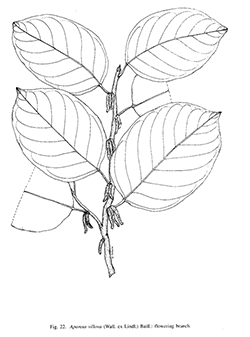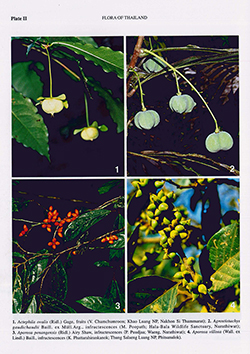e-Flora of Thailand
Volume 8 > Part 1 > Year 2005 > Page 102 > Euphorbiaceae > Aporosa
18. Aporosa villosa (Wall. ex Lindl.) Baill.wfo-0000249809
Étud. Gén. Euph: 645. 1858; Hook.f., Fl. Brit. Ind. 5: 345. 1887; Gagnep. in Lecomte, Fl. Indo-Chine 5: 559. 1927; Airy Shaw, Kew Bull. 26: 218. 1972.— Scepa villosa Wall. ex Lindl., Nat. Syst. ed. 2: 441. 1836. Fig. 22; Plate II: 4.
Accepted Name : This is currently accepted.
Synonyms & Citations :
Description : Shrub to tree, up to 15 m high; young branches densely tomentose. Stipules ovate, 4–6 by 2–3 mm, caducous. Leaves: petiole terete, 9–25 mm long, pulvini indistinct; blades ovate to elliptic, 8.5–30 by 6–12.5 cm, length/width ratio 1.4–2.4, coriaceous, drying greyish-brown to greenish brown (to bluish green) above, reddish brown beneath, base slightly cordate to rounded, basal glands small, hairy, margin subentire, marginal glands distinct, apex acute to acuminate, sparsely tomentose above, tomentose underneath, disc-like glands few, scattered within marginal arches; venation (usually slightly) raised on both sides, nerves in 8–11 pairs. Inflorescences axillary. Staminate inflorescences 2–6 together, 10–57 by 2–3 mm, tomentose; peduncle absent; bracts triangular, 1.2–2.2 mm long; glomerules with 5–7 laxly set flowers, set continuously along rachis. Staminate flowers 1.2–1.8 mm long; pedicel absent (or minute); sepals 4, obovate. 1–1.5 mm long; stamens 2 or 3, slightly exserted, 1.2–1.8 mm long; anthers 0.3–0.5 mm long; pistillode absent or a minute hair tuft. Pistillate inflorescences 1–4 together, 2–4 mm long, tomentose, flowers up to 7, densely set along rachis; bracts triangular, 1–1.5 mm long. Pistillate flowers 2.5–4.5 mm long, sessile; sepals 4, ovate, subequal, patent, 1–1.5 mm long; ovary 2 locular, densely tomentose; stigmas slightly raised, 0.8–1.5 mm long. Fruits ovoid to ellipsoid, not stiped, not beaked, 10–11 by 7–9 mm, drying reddish to light brown, sparsely tomentose, not fleshy, septae and column sparsely sericeous. Seeds 7–9 by 5–6.5 by 4–5 mm.
Thailand : NORTHERN: Mae Hong Son, Chiang Mai, Chiang Rai, Lampang, Sukhothai; NORTH-EASTERN: Phetchabun, Loei, Udon Thani, Nakhon Phanom, Mukdahan, Khon Kaen; EASTERN: Chaiyaphum, Surin, Si Sa Ket, Ubon Ratchathani; SOUTH-WESTERN: Uthai Thani, Kanchanaburi, Ratchaburi; SOUTH-EASTERN: Prachin Buri.
Distribution : Burma (type?), Laos, Cambodia, Vietnam.
Ecology : Evergreen, (mixed) deciduous, secondary, disturbed, or seasonal forests, dry or partly swampy; in open country, on planes, forests edges, or along roads; on (poor) sandy soil, limestone, or silt, bedrock granite; 300–1,500 m alt.
Vernacular : Mueat khon (เหมือดขน); mueat luang (เหมือดหลวง)(Chiang Mai); dang (ด่าง), daeng phong (แด่งพง)(Sukhothai); pradong kho (ประดงข้อ)(Phichit); mueat khwai (เหมือนควาย), mueat miang (เหมือคเมียง), mueat top (เหมืออตบ)(Northern); mueat Som (เหมือดส้ม)(Northeastern).
Uses: Wood is used for house construction. The fruit is edible (though not so nice).
Notes: Distinct from Aporosa octandra var. yunnanensis only by the shape of the leaves (see note under latter). Intermediates are possible.


